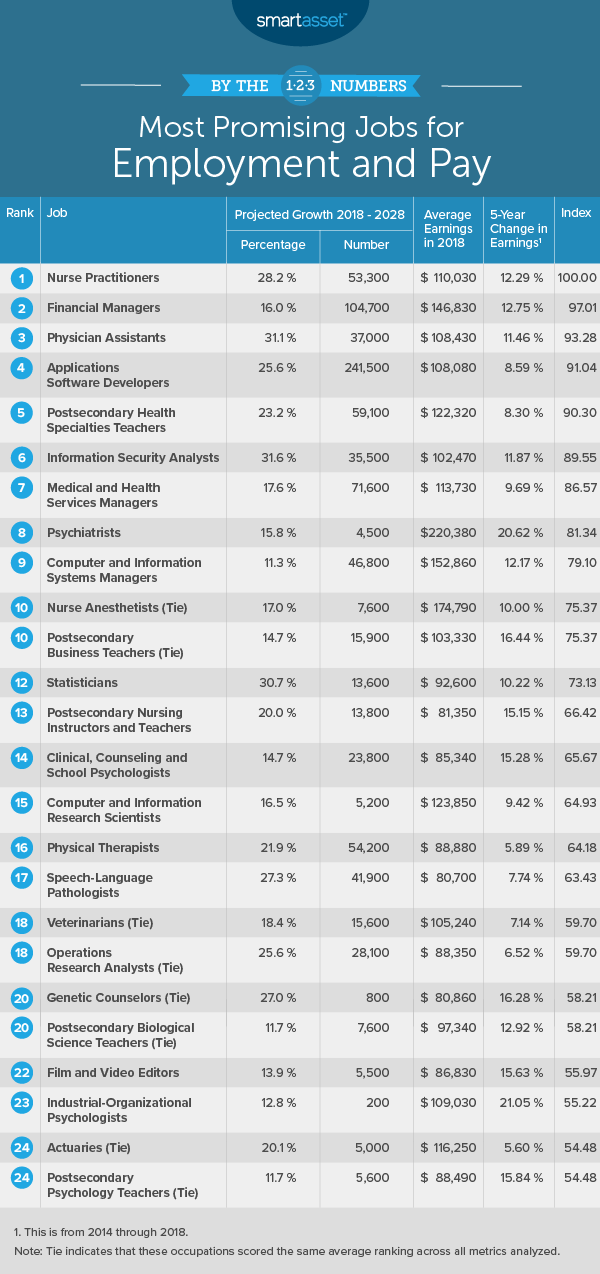 Every two years, the Bureau of Labor Statistics (BLS) releases employment projections for more than 800 detailed occupations, with its most recent projections spanning from 2018 to 2028. Solar photovoltaic installers and wind turbine service technicians top the list. The BLS projects employment growth of 63.3% and 56.9% for the occupations, respectively. Due to their relatively small number of employees, however, these high projections do not amount to many new jobs. Fewer than 7,000 workers are expected to join the ranks of solar photovoltaic installers and wind turbine service technicians by 2028. Meanwhile, the number of personal care aides is expected to grow by 36.4%, which translates to an increase of 881,000 workers in the next decade. Those employment opportunities can give workers the ability to save up in their retirement accounts.
Every two years, the Bureau of Labor Statistics (BLS) releases employment projections for more than 800 detailed occupations, with its most recent projections spanning from 2018 to 2028. Solar photovoltaic installers and wind turbine service technicians top the list. The BLS projects employment growth of 63.3% and 56.9% for the occupations, respectively. Due to their relatively small number of employees, however, these high projections do not amount to many new jobs. Fewer than 7,000 workers are expected to join the ranks of solar photovoltaic installers and wind turbine service technicians by 2028. Meanwhile, the number of personal care aides is expected to grow by 36.4%, which translates to an increase of 881,000 workers in the next decade. Those employment opportunities can give workers the ability to save up in their retirement accounts.
To account for the differences between projected percentage growth and growth in number of workers, SmartAsset looked at both of those metrics along with two pay metrics to determine some of the most promising jobs in the U.S. for both employment and pay. We filtered the total 808 occupations detailed by the BLS by those with greater than 10% projected growth over the next 10 years and 2018 mean earnings greater than $62,510, which is the 75th percentile of annual earnings nationally. This left us with 48 occupations, which we compared across four metrics: 10-year expected percentage growth, 10-year expected growth in number of workers, average earnings and five-year growth in earnings. For more information on our data sources or how we put together our findings, check out the Data and Methodology section below.

Key Findings
- Concentrated job fields. The BLS defines 22 job categories under which more than 800 detailed occupations fall. The top 25 jobs that we found to be the most promising for employment and pay are concentrated in six of those job categories. Moreover, 19 of the top 25 occupations fall in only three of the job categories. Those three categories include healthcare practitioners and technical occupations; computer and mathematical occupations and education, training and library occupations.
- Young professional workers are already flocking to the most promising jobs. Our recent study of the fastest-growing jobs for young professionals looked at five-year job growth for people between the ages of 25 and 34 who have a bachelor’s or advanced degree. There is significant overlap in top-ranking occupations between the findings of that study and this one. Nurse practitioners and physician assistants rank in the top 10 for both studies, and workers who have some of the fastest-growing jobs for young professionals may, with increased time and experience, be promoted to have one of the most promising occupations for employment and pay. For instance, computer systems analyst ranks as the eighth-fastest-growing job for young professionals, and computer and information system manager ranks ninth in this study. Similarly, financial analyst ties for 13th in the previous study while financial manager places as the second-most promising job for employment and pay.
Healthcare Practitioners and Technical Occupations
Eight of the occupations in our top 25 most promising jobs for employment and pay are healthcare practitioner and technical occupations. Moreover, of the eight, half also rank within the top 10. Those four include nurse practitioners, physician assistants, psychiatrists and nurse anesthetists, ranking first, third, eighth and 10th, respectively. Average earnings for all eight occupations in 2018 range from about $80,000 to about $220,000.
BLS predicts that nurse practitioners and physician assistants will have job growth of 28.2% and 31.1%, respectively, over the 10 years from 2018 to 2028. Additionally, average earnings for both occupations are high and may continue to rise, following the trend of the past five years. In 2018, average earnings for nurse practitioners were $110,030, 12.3% higher than they were in 2014. Similarly, in 2018, physician assistants made $108,430, up 11.5% from 2014.
Computer and Mathematical Occupations
Computer and mathematical occupations claim the second-most occupations in our top 25. On our list, applications software developers rank fourth, information security analysts rank sixth, statisticians rank 12th, computer and information research scientists rank 15th, operations research analysts rank 19th and actuaries rank 24th.
Applications software developers and information security analysts are expected to hire the greatest numbers of workers in the next 10 years of the six computer and mathematical occupations. Given the 25.6% and 31.6% projected 10-year growth for both occupations, respectively, there will be 241,500 more applications software developers and 35,500 more operations research analysts in 2028 than there were in 2018. Our study for the best American cities to work in tech may serve as a helpful guide of where to seek those jobs, as can our study on the best cities for diversity in the STEM workforce.
Education, Training and Library Occupations
All five of the education, training and library occupations in our top 25 are beyond the high school level. The five occupations include postsecondary health specialties teachers, postsecondary business teachers, postsecondary nursing instructors and teachers, postsecondary biological science teachers and postsecondary psychology teachers.
Average earnings for the five occupations in 2018 range from about $80,000 to $120,000. In 2018, postsecondary health specialties teachers made $122,320 annually on average, while postsecondary nursing instructors and teachers earned $81,350 on average.
Management Occupations
Three of the occupations in our top 25 most promising jobs for employment and pay are management occupations. They include financial managers, medical and health service managers and computer and information system managers, ranking second, seventh and ninth, respectively.
Combined, BLS predicts that almost 225,000 workers will join those three occupations within the next 10 years. Of the three, financial managers are projected to add the most workers to their ranks. BLS estimates that there will be 104,700 more financial managers in 2028 than there were in 2018, the fifth-highest expected 10-year growth in number of workers of any of the 48 occupations we considered.
Life, Physical and Social Science Occupations
Clinical, counseling and school psychologists and industrial-organizational psychologists – both categorized by BLS as life, physical and social science occupations – rank 14th and 23rd, respectively, on our list. Both occupations are expected to grow by more than 12% over the next 10 years and have experienced strong earnings growth over the past five years. Specifically, between 2014 and 2018, average earnings for clinical, counseling and school psychologists increased by 15.28%, while industrial-organizational psychologists saw average earnings increase by 21.05%. They may prove all the more useful in cities suffering from the most financial stress.
Arts, Design, Entertainment, Sports and Media Occupations
In our top 25, only one occupation, film and video editor, falls under the BLS category of arts, design, entertainment, sports and media occupations. Ranking 22nd overall, film and video editor does particularly well for the metric of five-year earnings growth. Average earnings for film and video editors increased by 15.63% from 2014 through 2018, the sixth-biggest increase in earnings for any of the 48 occupations we considered. In 2018, average earnings for film and video editors were $86,830, almost $25,000 more than the 75th percentile of earnings nationally for all occupations.
Data and Methodology
To find the most promising jobs for employment and growth, we filtered the total 808 occupations detailed by the BLS by projected growth and earnings, looking specifically for jobs with greater than 10% projected growth over the next 10 years and 2018 mean earnings greater than $62,510, the 75th percentile of annual earnings nationally. We also filtered out any occupation with “other” in the title due to lack of specificity. We compared the remaining 48 occupations across the following four metrics:
- 10-year expected percentage growth. Data comes from the Bureau of Labor Statistics and is for 2018 through 2028.
- 10-year expected growth in number of workers. Data comes from the Bureau of Labor Statistics and is for 2018 through 2028.
- Average earnings. This is the national mean earnings for workers in each occupation. Data comes from the Bureau of Labor Statistics and is for 2018.
- Five-year growth in earnings. Data comes from the Bureau of Labor Statistics and is for 2014 through 2018.
Using the four metrics above, we ranked each occupation in every metric, giving all metrics an equal weighting. We then found each occupation’s average ranking and used the average to determine a final score. The occupation with the best average ranking received a score of 100. The occupation with the lowest average ranking received a score of 0.
Tips for Saving for Retirement
- Smarter savings. As you grow your career, it’s important to grow your savings as well in order to make sure you have enough set aside for your future. Take advantage of your employer’s 401(k) match if available, and use a comprehensive retirement calculator to get a sense of what your situation might look like.
- Invest in professional insight. You may be an expert in your career, but that doesn’t mean you know the best way to grow your money through smart investing. Consider seeking the advice of an expert advisor to help you make the most of your hard-earned money. Finding the right financial advisor that fits your needs doesn’t have to be hard. SmartAsset’s free tool matches you with financial advisors in your area in five minutes. If you’re ready to be matched with local advisors that will help you achieve your financial goals, get started now.
Questions about our study? Contact us at press@smartasset.com
Photo credit: ©iStock.com/laflor